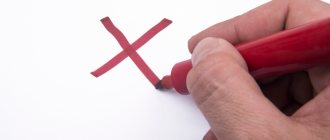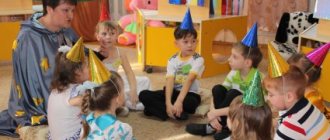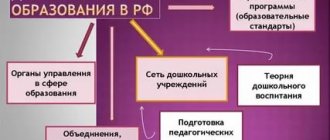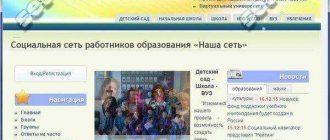In 2020, the requirements for educational standards have changed, so you will have to work longer than usual on the annual plan. Due to the pandemic and updates to the law, 5 major tasks need to be added to the plan.
We recommend that you start preparing your plan with new items, because they will take the most time. If you have already drawn up a plan without taking into account new tasks, write them down on the adjustment sheet:
- Last year's goals
- Remote technologies
- Anti-terrorism protection
- Networking
- Parent Consultation Center
- Approval and control of the annual plan
Approval and control of the annual plan
When a new annual plan has been drawn up, all tasks have been spelled out and their executors have been appointed, you need to agree on the final version of the plan. Usually it is agreed upon with the teaching council. To do this, send an electronic version of the plan to employees the day before the meeting so that they have time to familiarize themselves and prepare their proposals and questions. If disagreements arise at the meeting, revise the plan accordingly. If the teaching council has no objections, put the stamp “Approved”.
After the plan is approved, new tasks must be communicated and instructions issued to everyone involved in their implementation. Then you can post the annual plan on the official website. If you decide to publish it, please exclude from the public version any information that should not be shared publicly. For example, information about working with official documentation or details of the anti-terrorist protection plan for preschool educational institutions.
Once the team begins implementing the plan, monitor its progress at a monthly meeting. To do this, it is convenient to create a checklist in which employees will note what they have completed and what they have not. In this sheet you need to register the reporting activities, performers and deadlines.
If you found this article helpful, please rate it on the star scale below, with 5 stars being very helpful.
We want you to read only interesting materials, and we will be grateful for your feedback!
Current trends in modern education in preschool educational institutions article
Current trends in modern education in preschool educational institutions
Relevant trends of modern education in preschool educational institution
UDC 3 37.37.01/.09 37.02
This article discusses current trends in preschool educational institutions: smart learning, educational robotics, learning outside of class, educational games, social media, STEAM.
In this article modern trends in preschool educational institution are considered: smart training, educational robotics, training out of occupations, educational games, social media, STEAM.
Keywords: trends, education, technology, STEAM, smart learning, educational robotics, educational games, social media, training, classes.
Keywords: trends, education, technologies, STEAM, smart training, educational robotics, educational games, social media, training, occupations.
The 21st century is the century of globalization, new technologies and innovations, the century of new thinking and a new attitude to the changes taking place. The dynamism and interdependence of the ongoing changes dictate the need for a new approach to the education system. Trends in education are trends in its change.
Let us pay attention to the trends of the Federal State Educational Standard for Educational Education in order to correlate them with the possibilities of the considered educational trends[3].
1. The Federal State Educational Standard for Educational Education is based on a system-activity approach. It is necessary to individualize each child, regardless of his characteristics.
2. The main goal of the Federal State Educational Standard for Preschool Education is the full development of the individual based on the formation of universal educational actions, mastering and knowing the world (in the form of games, cognitive and research activities, creative activity).
3. The innovative nature of the standards is the requirements for the conditions for the implementation of education.
4. Educational areas, as well as activities outside the classroom, appear in the plans.
5. The Federal State Educational Standard for Education puts educational technology at the forefront. Over the past decade, the education system has been actively introducing pedagogical innovations and computer teaching methodologies in order to improve the quality of education and its results.
6. Value guidelines in the Federal State Educational Standard for Educational Education are shifted: from community and collectivism to individualization, from cognitive activity to socialization.
Over the past decade, the education system has been actively introducing pedagogical innovations and computer teaching methodologies in order to improve the quality of education and its results.
Smart learning is the first learning trend consisting of the merging of online distribution of software and content in the form of multimedia.
The main goal of Smart education is to create an environment that provides a high level of competitive education through the development of students’ knowledge and skills of modern society of the 21st century: cooperation, communication, social responsibility, the ability to think critically, quickly and efficiently solve problems [1, p.1 ].
The second trend is educational robotics, which takes a modern approach to introducing elements of technical creativity into the pedagogical process through the combination of design and programming.
Robotics classes provide opportunities for diversified development and formation of the most important competencies outlined in the new generation standards:
- skills in conducting experimental research: putting forward hypotheses, searching for solutions, conducting observations and measurements, establishing cause-and-effect relationships, assessing the influence of individual factors, processing and analyzing results;
- development of creative, imaginative, spatial, logical, critical thinking;
- development of communicative competence: teamwork (in pairs, groups) to develop and implement ideas, plan and implement activities, develop vocabulary and communication skills.
Learning outside of class is the third trend. This is a format of learning through activities, which may include research and application of knowledge in practice. Such training can take place in the form of a game, a quest, geocaching, photo hunting, or a hike. At the same time, children and their parents are “immersed” in history, culture, and nature, since certain tasks are set and appear before them.
The fourth trend in modern education is social media. The social service Facebook, Google services and tools, the Wiki website, podcasts for distributing sound files or videos on the Internet, blogs, YouTube video hosting - all this can and should be used in the classroom.
In conducting leisure, entertainment, games, and matinees, multimedia tools perform a special task: they clearly convey the thematic content of the event, accompany it with sound and light effects, which certainly increases the quality level of the event.
The introduction of educational games into teaching is the fifth trend of our time. Serious educational games are created for a variety of educational areas. There is, for example, a game that simulates the process of climate change, or a medical game to solve an environmental problem, and the like.
One of the main trends in global education is STEAM. The sixth trend is a new educational technology that combines several subject areas as a tool for developing critical thinking, research competencies and group work skills.
The abbreviation STEAM stands for:
S – science,
T – technology,
E – engineering,
A – art,
M – mathematics.
Or natural sciences, technology, engineering, creativity, mathematics - disciplines that are becoming the most popular in the modern world. Instead of studying each of the five disciplines separately, STEAM integrates them into a single learning framework.
At the International Conference “STEAM forward”, which was held in 2014 in Jerusalem, the following statements were made: “Involving children in STEAM. This education should begin from a very early preschool age, and therefore it is necessary to introduce programs in kindergartens[5].”
An important feature of working with this technology is the collective work on the project. STEAM – allows you to use the right hemisphere of the brain, which is responsible for creativity, emotions, and feelings. There are many examples of successful design work using this technology.
And no matter how successful traditional methods of education and training may be, modern reality requires the search for new and effective forms.
Instill the skills of independent learning throughout life, teach interaction at different levels, develop independent and critical thinking - these and many other principles constitute the strategy for the development of modern educational technologies[4].
If we are preparing our children for later life, then we must allow them to use those tools that will still become part of their daily life in the future.
Bibliography:
1.Ten A.S. and others. Smart training in the system of advanced training for teachers. Toolkit. -Almaty: JSC NTsPK "Orleu". 2014. -112 p.
2. Case Thurlow. Ten trends in modern education URL: https://www.hse.ru/news/media/63841790.html
3.Trends of modern education. Features of educational trends
URL: https://sites.google.com/site/trendsofedu/fgos
4. The course “Modern educational technologies and SMART” is your guide to new opportunities for using ICT in the classroom. URL: https://edguru.ru/blog/edutrends/
5. Tamara Strelnikova. What is STEAM education?
URL: https://www.unikaz.asia/ru/content/chto-takoe-steam-obrazovanie
Change #2. New rules for accreditation and accreditation monitoring
The changes will come into force on March 1, 2022, in accordance with Federal Law No. 170-FZ of June 11, 2022. Accreditation will become permanent. Those schools are accredited that meet accreditation indicators - they were approved separately for three levels of general education: primary, basic and secondary (Order of the Ministry of Education dated November 29, 2021 No. 868). We introduced annual accreditation monitoring of all schools. Various indicators have been approved for monitoring and supervision. Indicators for supervision at three levels of general education are the same. The school must score 30 points for each group of accreditation indicators. If the points are not enough, sanctions will be applied to the school: an order, a fine, deprivation of a license, etc.
Change #10. Transition to electronic sick leave certificates
From January 1, 2022, schools will only accept electronic certificates of incapacity for work to assign and pay benefits for temporary disability or maternity leave. Sick leave certificates are no longer issued on paper. To accept an electronic form for payment of temporary disability, the accounting department only needs the document number, but employees are not required to print it out. You can obtain information about electronic sick leave in different ways: at State Services; in a clinic or hospital that sent an employee on sick leave; in the personal account of the recipient of FSS services. You can work with electronic sick leave in almost any accounting program. Read more in the recommendations of the Head Teacher System experts “How to pay sick leave benefits.”
Change #7. New procedure for fire safety training
It will come into effect on March 1, 2022. A new form of log of briefings and requirements for the training program have been approved. Instead of the fire-technical minimum, employers are required to organize training in additional professional programs in the field of fire safety. The types of briefings remained unchanged, but their frequency and reasons changed. Thus, unscheduled training does not need to be carried out if the employee had a 30-day break from performing duties. The training program must meet the new requirements. For introductory and initial briefings, a list of mandatory topics was approved. The content of unscheduled and targeted briefings is determined by schools themselves. Issue an order to appoint those in charge and distribute instructions. Use a ready-made sample.
Change #8. Changes in procurement
On January 1, 2022, changes to Law No. 44-FZ on public procurement came into force. We reduced the list of competitive procurement methods and eliminated the request for proposals. We left a competition and auction, including closed ones, and an electronic request for quotes. We increased the limit on the annual volume of purchases by conducting a request for quotations. Purchase documents must be generated only for closed purchases. Mandatory prequalification was introduced for procurement participants. We have expanded the list of persons who can issue guarantees to secure applications, fulfillment of contracts and warranty obligations. The procedure for unilateral refusal to fulfill a contract has been changed. Now the decision to refuse must be handed over to the counterparty personally against signature or sent by registered mail to the address specified in the contract.
Changes regarding the operation of schools from March 1, 2022
In 2022, numerous changes will come into force regarding the work of schools: in the field of labor protection, fire safety, organization of the work process and educational activities, passing the Unified State Examination and the Unified State Examination, and others. All current changes are described in this article. In total, the work of schools and educational organizations will be affected by 13 important changes. The first part of the changes requires a new organization of labor protection, work process, and payments to teachers and other school employees. The second part of the changes concerns the organization of the educational process.
Change #11. New professional standard for school leaders
From March 1, 2022, the professional standard of the head of an educational organization will come into force, according to the order of the Ministry of Labor dated April 19, 2021 No. 250 n. The new professional standard will be applied when appointing a school director and drawing up an employment contract. In the employment contract, the wording of the director’s duties will change, they will become more specific, and their list will be broader. Thus, the head will be obliged to implement state policy in the field of digital transformation of an educational organization and develop a digital educational environment.
Change #6. Occupational Safety and Health
From March 1, 2022, amendments to the Labor Code on labor protection, approved by Order of the Ministry of Labor of Russia dated October 29, 2021 No. 772 no., will come into force. The main ones are: document flow on labor protection can be done electronically; You can install video surveillance, microphones and other types of remote control at workplaces. Employees must be warned that their work is being monitored; employers have a list of new responsibilities; it is necessary to update instructions and rules in the field of labor protection; schools should have someone responsible for recording and investigating microtraumas. According to the order of the Ministry of Labor dated October 29, 2021 No. 774 n, from March 1, 2022, new requirements for organizing a safe workplace will apply. Draw up a schedule to gradually introduce all innovations in the field of labor protection. Determine who is responsible and the timing of the activities. You can use a ready-made sample Schedule for modernizing the occupational safety system at school
Change #3. New Federal State Educational Standards for primary and basic general education
From September 1, 2022, children will be admitted to study in the 1st and 5th grades only according to the new Federal State Educational Standards (clause 2 of the order of the Ministry of Education dated 05/31/2021 No. 286, clause 2 of the order of the Ministry of Education dated 05/31/2021 No. 287). OOP NOO and OOP LLC need to be drawn up according to new standards, it is also necessary to check local acts and adjust those that contradict the new Federal State Educational Standards, or approve new ones. If a school transfers primary and secondary schools to the new Federal State Educational Standards, it is obliged to collect consent from all parents. It is also necessary to approve new programs and local acts. This must be done before admission of students to grades 1 and 5 begins. Parents must review the documents before applying for admission.
Change #1. Changes in the list of documents for enrolling a child in school
From March 1, 2022, the list of documents for admitting students to school will change. This will affect beneficiaries who have an advantage in enrollment. Update the list of documents on the school website and information stand. Use the ready-made reminder.
Memo. Documents for enrollment in school in 2022
Change #9. New rules for license renewal
From March 1, 2022, in order to make changes to the register of licenses, it is necessary to submit a shortened list of documents, in accordance with Government Decree No. 2124 dated November 30, 2022. To re-issue a license in a branch, you do not need to submit a sanitary and epidemiological certificate for premises and equipment, a letter of guarantee on attracting teachers and regulations on the branch. The licensing authority accepts documents only through the State Services portal, and not in person. Starting from 2022, entries in the license register will be made within 5 working days. The verification has become only documentary, so 45 days are not required to verify an educational organization.
Change No. 12. The minimum wage has increased
According to Federal Law No. 406-FZ of December 6, 2022, from January 1, 2022, the minimum wage increased by 1,098 rubles. The increase was more than 8%, now the minimum wage is 13,890 rubles per month. This means that human resources and accounting professionals are required to compare the salaries of school employees with the new federal minimum wage. The federal minimum wage is used in several cases: a local minimum wage has not been established in the region, the school has officially refused to comply with the terms of the regional agreement; The educational organization is financed from the federal budget. In the listed cases, the regional minimum wage does not apply to the school (Part 2 of Article 133.1 of the Labor Code). If employees' wages are below the new minimum amount, the employer is obliged to issue an order for additional payment. It reflects the name and position of the employee, the amount of additional payment and the start date of payment.
Change No. 13. New procedure for obtaining consent for medical intervention and refusal
The Ministry of Health approved by order No. 1051 dated November 12, 2021 a new procedure for giving voluntary consent to types of medical interventions and refusing them. From March 1, 2022, the relevant documents will have to be filled out using a new form. The consent must contain information about the persons to whom doctors can transfer data about the patient’s health. The refusal additionally records possible consequences. If the school has a medical license, health workers are required to issue consents and waivers. If a license is not available, the documents are signed by health workers at the clinic serving the school.
Source: Read more ➤
Source: Read more ➤






